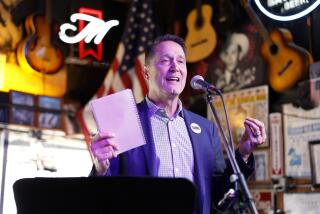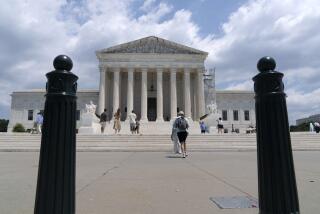Book review: ‘Common as Air’ by Lewis Hyde
Common as Air
Revolution, Art and Ownership
Lewis Hyde
Farrar, Straus & Giroux: 306 pp., $26
The late Jack Valenti, who was Hollywood’s ubiquitous lobbyist for four decades, fully agreed that copyright terms should be limited. The proper term, he would say, is “forever, minus a day.”
As is pointed out by Lewis Hyde, a creative writing professor at Kenyon College in Ohio and expert on intellectual property issues at Harvard’s Berkman Center for Internet and Society, Valenti’s wish has become true, or true enough. In the United States, for most works published after 1978 and all works published after 2002, the copyright term runs to the death of the author plus 70 years. Economically speaking, it might as well be infinite.
Hyde’s penetrating new book, “Common as Air,” traces the history of intellectual property ownership, the changes in technology and social conditions that have influenced the law over the centuries, and the state of the law today. His conclusion, and it’s inescapable, is that copyright and patent protections have gotten out of control. Worse, they threaten today to stifle creativity across the artistic spectrum and hamper the advance of scientific discovery. They give heirs of artists and public figures excessive power to control public discourse, as is the case with the demands by the offspring of the Rev. Martin Luther King Jr. for steep fees for republication of his “I Have a Dream” speech.
Hyde argues that it’s time to strike a new balance between the incentives and compensation that will encourage creative minds to keep writing, drawing, composing and inventing, and the need to place their work in the public domain after a decent interval. More precisely, he suggests that we reexamine the principles of earlier times to find formulas that work today. He accepts that technology may have rendered some copyright principles obsolete. Consider the “first sale doctrine,” which governed the rights of buyers of books, records, videotapes and other such physical embodiments of intellectual content. It was long acknowledged that once you bought a book you could lend it, give it away, read it to your child, paste pages of it in your diary or resell it — you couldn’t print more copies, but that was about the only limitation.
Is “first sale” obsolete in the digital age, when every download is a new copy? Hyde acknowledges that it might be, explaining that publishers’ concerns about the dangers of costless copying are what leads to draconian constraints on the rights of buyers of e-books or song MP3s: There’s no way for me to “lend” anyone the e-books on my Amazon Kindle (though others are experimenting with lendable e-books) and there are even limits on how many of my own Kindles I can keep my books on (usually six). By the way, I don’t buy books for my Kindle; Amazon grants me a license, and it’s revocable.
The desire to control customer usage has led to some absurd rules — Hyde mentions an e-book of “Alice in Wonderland” that bears the warning “This book cannot be read aloud,” and an electronic copy of the U.S. Constitution sold on Amazon that was encoded to prevent its being printed out more than twice a year. He calls these “silly examples,” but the evidence in his book suggests that publishers will continue to test the limits of digital rights until society, or Congress, settles on a model that conjoins fairness and profitability.
Then there’s the patent mess. Patent law used to have no problem distinguishing between “discoveries” and “inventions.” The first, which were elucidations of the natural world, were not patentable; the second, which were creations of evident utility, were. Over the last few decades that distinction has been eroded, under pressure from commercial interests. Today, a company can patent portions of a DNA molecule, even if it has no idea what that sequence does; pharmaceutical companies can patent natural organisms if they can claim a new way to isolate and purify them. Even “business methods” can be patented.
These developments cannot help but cause mischief, or worse, in science and commerce. University researchers avoid certain experiments because they fear running afoul of patents lurking in a corporate portfolio. Just this summer, Microsoft co-founder Paul Allen sued several e-commerce companies for infringing on patents issued years ago to a research center he funded. Some of the patents were for online services that today seem mundane, such as news aggregation sites; Allen never exploited the rights himself, but held on to the patents until he could spring them on successful firms. No one is quite sure whether he can make the claims stick, but patent attorneys agree that it will cost the defendants millions in court to find out.
Hyde’s informative and troubling book is a brief for reestablishing sensible terms for common ownership of ideas, discoveries, and, yes, creations and inventions. In recent years, the debate has been framed only by the creativity of lawyers, as in my favorite absurdist case history in “Common as Air”: In 2002, a British musician inserted a certain short track in a recording, and jokingly named the avant-garde composer John Cage’s work “4’33” as his inspiration. A lawsuit for infringement was duly filed by the Cage estate’s lawyers, followed by legal maneuvering and an out-of-court settlement. Here’s the punch line: The infringing track comprised one minute — and Cage’s work four minutes and 33 seconds — of silence.
Hiltzik is the author of “Colossus: Hoover Dam and the Making of the American Century.” His column runs Sundays and Wednesdays in The Times’ Business section.
More to Read
The biggest entertainment stories
Get our big stories about Hollywood, film, television, music, arts, culture and more right in your inbox as soon as they publish.
You may occasionally receive promotional content from the Los Angeles Times.











